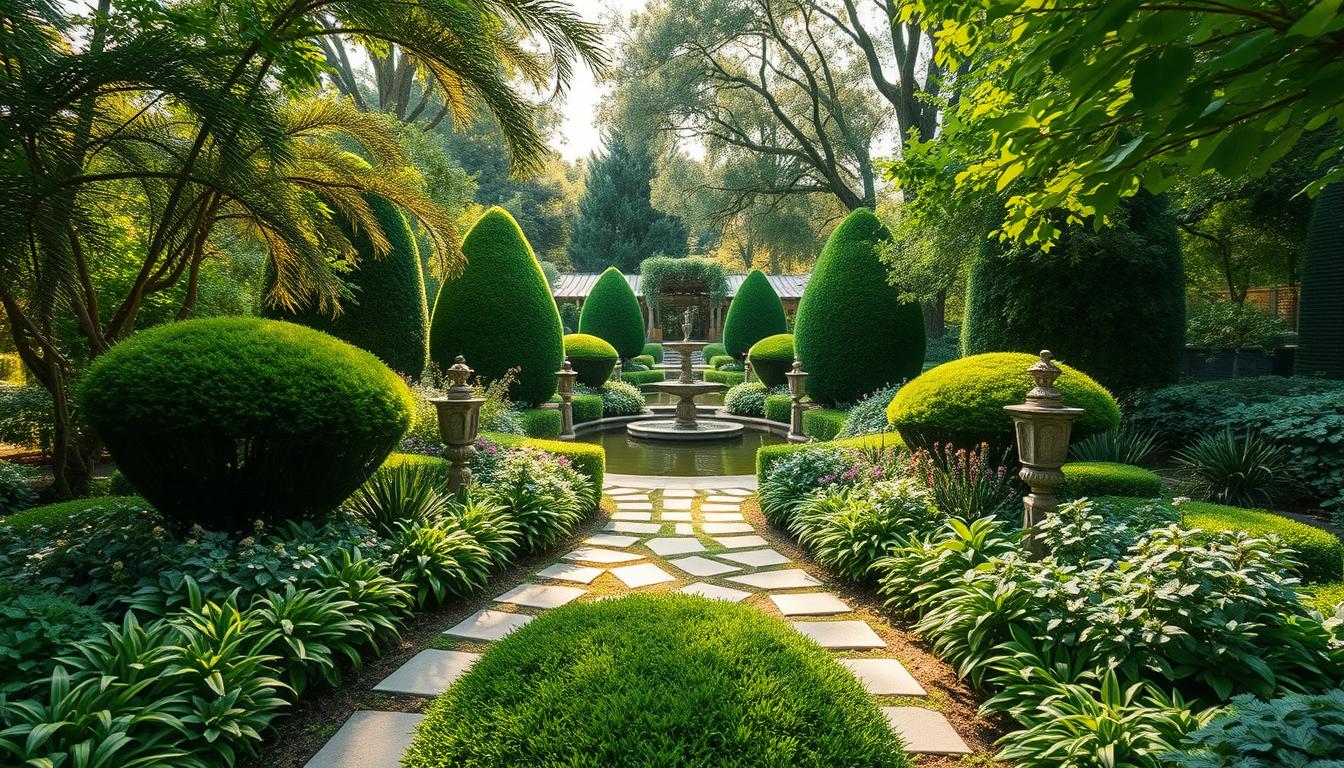Creating a stunning outdoor area can transform your home into a personal retreat. Thoughtful planning ensures every corner of your yard becomes a functional and beautiful space. Whether you’re dreaming of a cozy woodland path or vibrant winter blooms, the possibilities are endless.
Expert sources like Gardenary and Monrovia’s landscape guides offer valuable insights to help you craft the perfect layout. These resources highlight the benefits of intentional planning, from boosting property value to creating eco-friendly habitats. Your outdoor area can also become a source of joy and relaxation.
No matter the size of your yard or the climate you live in, there’s a design that fits your needs. Explore 17 specialized ideas to find the one that speaks to you. Let’s dive into how you can create a space that’s both practical and inspiring.
Key Takeaways
- Intentional planning transforms outdoor areas into functional and beautiful spaces.
- Explore 17 specialized designs, from woodland paths to winter blooms.
- Expert sources like Gardenary and Monrovia provide valuable guidance.
- Benefits include increased property value and eco-friendly habitats.
- Designs are adaptable to various climates and yard sizes.
- Create a space that brings personal enjoyment and relaxation.
Introduction to Garden Design
Transforming your yard into a curated space brings both beauty and purpose. A well-organized outdoor area not only enhances your home’s appeal but also creates a functional environment for relaxation and enjoyment. Whether you’re working with a sprawling lawn or a compact balcony, thoughtful design can make all the difference.
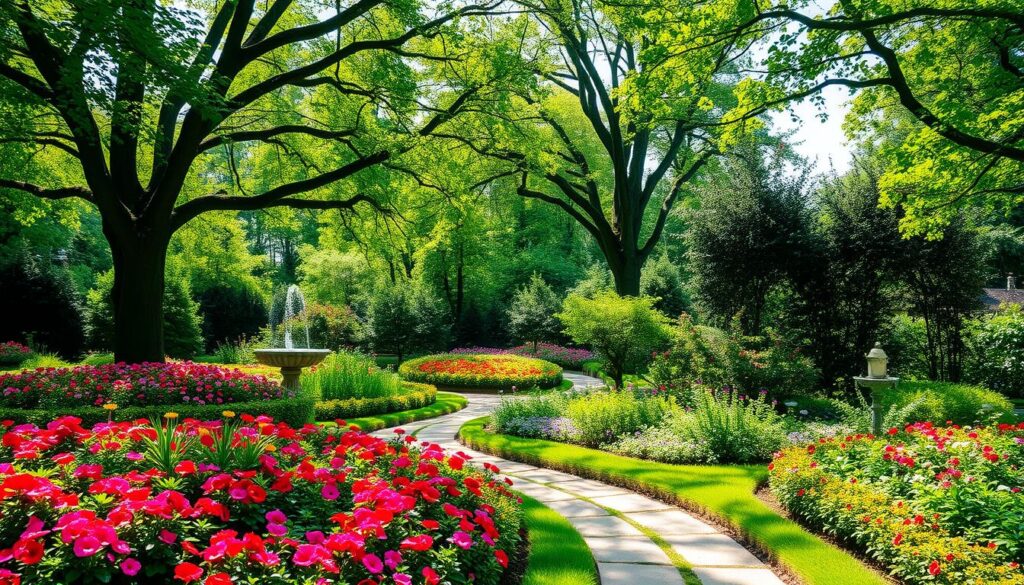
Why Garden Design Matters
Curated outdoor spaces have a profound emotional impact. They provide a sanctuary where you can unwind, connect with nature, and recharge. Adding elements like trellises not only maximizes space but also introduces vertical growth, which can prevent diseases and add year-round structure. For example, Gardenary’s trellises can increase growing area by 300%, turning 8 sq.ft of ground space into 24 sq.ft of vertical yield.
Benefits of a Well-Designed Garden
A thoughtfully arranged outdoor area offers numerous advantages. Research from Monrovia shows that planned spaces attract 65% more pollinators, boosting biodiversity. Additionally, urban setups like balcony gardens can produce impressive yields—some even harvest up to 50lbs of veggies annually. By integrating the right plants and structures, you can create a space that’s both productive and visually stunning.
Understanding Your Space
Before diving into planting, take time to evaluate your yard’s unique characteristics. Understanding your space is essential for creating a functional and beautiful outdoor area. Start by analyzing the soil, sunlight, and drainage to ensure your plants thrive.

Assessing Your Garden Area
Begin with a soil test using USDA zone maps to determine its composition and pH level. This step ensures your soil is suitable for the plants you want to grow. Next, use smartphone apps to track sunlight patterns over three days, as recommended by Monrovia’s Ultimate Planning Guide. This helps identify the best spots for sun-loving or shade-tolerant plants.
If your yard has clay or hardpan soils, consider drainage solutions like raised beds or French drains. These prevent waterlogging and promote healthy root growth. For inspiration, Jon Carloftis’ kitchen garden plans showcase effective companion planting strategies that maximize space and yield.
Choosing the Right Layout
Once you’ve assessed your area, it’s time to plan the layout. Think about how you’ll use the space—whether for relaxation, entertaining, or growing food. A 10×10 shady corner, for example, can be transformed into a serene fern sanctuary with the right design.
Consider vertical elements like trellises to maximize growing space. Companion planting can also enhance your layout by pairing plants that benefit each other. With thoughtful planning, your outdoor area will become a harmonious and productive retreat.
Popular Garden Design Plans
Discover how tailored layouts can elevate your outdoor experience. Whether you’re drawn to natural woodland paths or vibrant textures, these ideas will inspire your next project. Let’s explore three standout layouts that combine beauty and practicality.
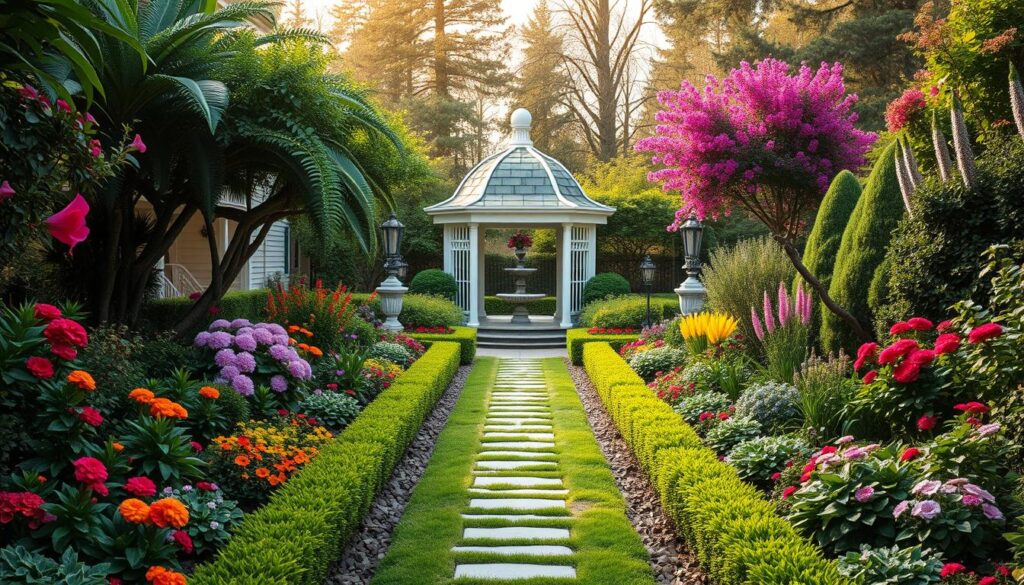
Woodland Path Garden Plan
This layout brings the charm of a forest to your yard. It features 60% native ferns, 30% spring ephemerals, and 10% hardscape elements. The result is a serene, natural pathway that blends seamlessly with its surroundings.
Native ferns thrive in shaded areas, while spring ephemerals add bursts of color. Hardscape elements like stone steps or benches provide structure and functionality. This design is perfect for creating a peaceful retreat.
Bark-Appeal Garden Plan
For those who love texture, this layout focuses on plants with exfoliating bark. The paperbark maple (Acer griseum) and river birch (Betula nigra) are standout choices. Their unique bark adds visual interest, especially in winter.
These plants are low-maintenance and thrive in various climates. Pair them with evergreen shrubs for year-round appeal. This layout is ideal for adding depth and character to your space.
Deer-Resistant Garden Plan
If deer are a concern, this layout is a game-changer. It combines Russian sage, lavender, and ornamental onion to create a deer-resistant haven. These plants are not only beautiful but also deter wildlife effectively.
A Vermont trial showed an 85% reduction in deer damage with this formula. These plants thrive in sunny areas and require minimal care. This design ensures your outdoor area remains untouched and vibrant.
“The right plants can transform your space into a sanctuary while solving common challenges.”
| Layout | Key Plants | Benefits |
|---|---|---|
| Woodland Path | Native ferns, spring ephemerals | Natural, serene retreat |
| Bark-Appeal | Paperbark maple, river birch | Year-round texture and interest |
| Deer-Resistant | Russian sage, lavender, ornamental onion | Effective wildlife deterrent |
For more inspiration, check out Monrovia’s 2024 downloadable PDF guides. These resources offer detailed blueprints to help you bring your vision to life. Start crafting your dream outdoor space today!
Creating a Pollinator Garden
Supporting bees and butterflies adds vibrancy and ecological balance to your yard. A pollinator-friendly space not only enhances the beauty of your surroundings but also plays a crucial role in maintaining healthy ecosystems. By carefully selecting plants and following thoughtful design principles, you can create a haven that attracts these essential creatures.
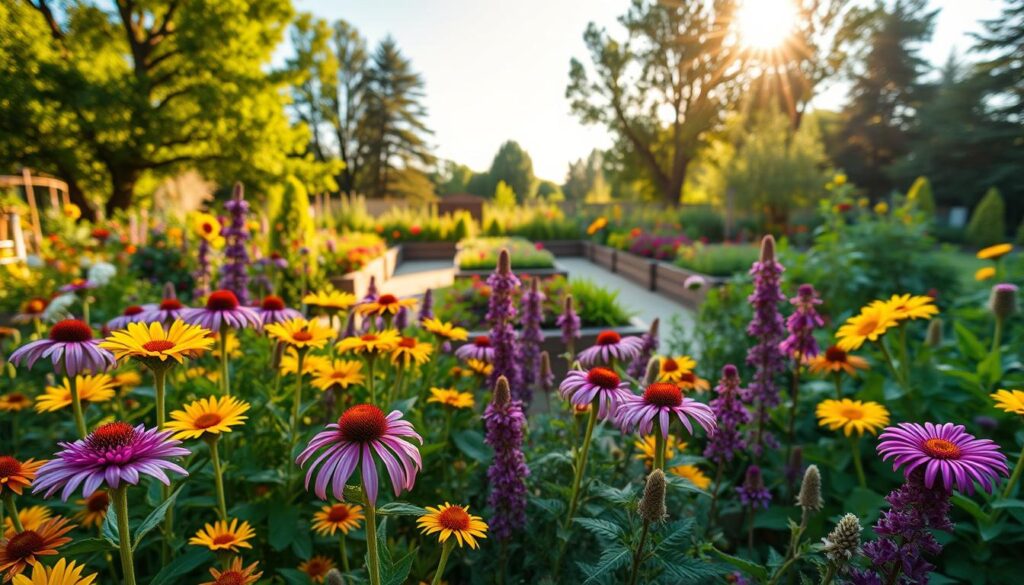
Plants That Attract Bees and Butterflies
Choosing the right plants is key to attracting pollinators. Monrovia’s Backyard Habitat Guide recommends a 5:3:2 ratio of nectar, host, and shelter plants. Top performers include butterfly weed (Asclepias), anise hyssop, and Joe-Pye weed. These species provide essential nutrients and habitats for bees and butterflies.
Design Tips for Pollinator Gardens
Effective design ensures your space is both functional and inviting. Group plants with the same hues in 3-foot diameter clusters to create visual appeal. Adding a birdbath with a pebble landing pad provides a water source for pollinators. Seasonal bloom sequencing ensures a continuous food supply throughout the year.
“A well-planned pollinator habitat not only supports wildlife but also transforms your space into a thriving ecosystem.”
| Plant Type | Examples | Benefits |
|---|---|---|
| Nectar Plants | Butterfly weed, anise hyssop | Provide essential food for pollinators |
| Host Plants | Milkweed, parsley | Support butterfly larvae |
| Shelter Plants | Ornamental grasses, shrubs | Offer protection and nesting sites |
For those seeking certification, the Xerces Society provides guidelines to ensure your space meets pollinator habitat standards. Start planning your pollinator-friendly area today and enjoy the beauty and benefits it brings.
The Ultimate Kitchen Garden Plan
A kitchen garden is a practical and rewarding way to grow fresh produce right at home. Whether you’re a seasoned gardener or a beginner, this space can provide a steady supply of edible delights while enhancing your outdoor area. Let’s explore how to create a thriving kitchen garden that’s both functional and beautiful.

Selecting Edible Plants
Choosing the right plants is the first step to a successful kitchen garden. Focus on varieties that suit your climate and taste preferences. Popular choices include tomatoes, basil, and marigolds, which thrive together through companion planting. Herbs like rosemary and thyme are also excellent additions, offering both flavor and fragrance.
Jon Carloftis’ spiral herb garden design is a standout example, increasing yield by 40%. This innovative approach maximizes space while creating a visually appealing layout. Consider incorporating vertical elements like obelisks for cucumbers or towers for strawberries to further optimize your space.
Layout and Maintenance Tips
A well-thought-out layout ensures your kitchen garden remains productive and easy to manage. Start with a succession planting schedule tailored to USDA zones 5-8. This ensures a continuous harvest throughout the growing season.
Organic pest control methods, such as neem oil spray, keep your plants healthy without harmful chemicals. Regular harvesting techniques, like picking herbs frequently, encourage continuous growth and production. With these tips, your kitchen garden will thrive and provide fresh, homegrown ingredients year-round.
Wildflower Garden Ideas
Bringing a touch of nature’s beauty to your yard can be as simple as planting wildflowers. These vibrant blooms not only add color but also support local ecosystems. Whether you’re looking to create a meadow-like retreat or a small patch of natural charm, wildflowers are a versatile and eco-friendly choice.
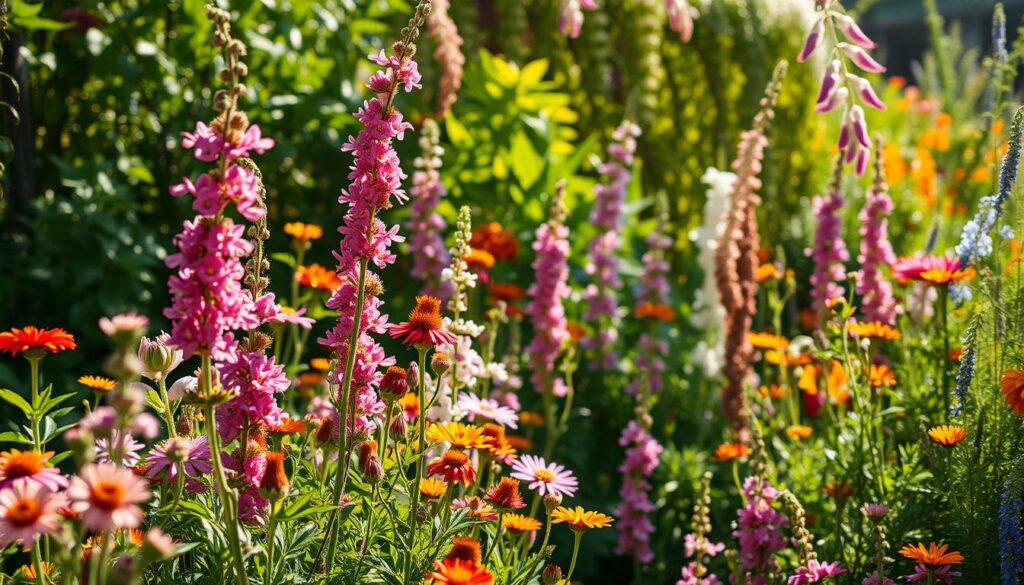
Benefits of Wildflowers
Wildflowers offer numerous advantages for your outdoor space. They require minimal maintenance and are naturally adapted to local climates. According to Monrovia’s 2023 guide, native wildflowers can reduce watering needs by up to 90%, making them a sustainable option.
These blooms also promote diversity by attracting pollinators like bees and butterflies. Their presence enhances the ecological balance of your area, creating a thriving habitat for wildlife. Plus, wildflowers add a unique, natural aesthetic that’s hard to replicate with traditional landscaping.
How to Grow a Wildflower Garden
Starting a wildflower garden is easier than you might think. Begin with site preparation, choosing between solarization or smother cropping to clear the area. A balanced seed mix of 70% perennials and 30% annuals ensures long-lasting blooms and seasonal variety.
Consider regional native mixes, such as Northeast or Southwest blends, to ensure your plants thrive. Maintenance is simple: focus on first-year care to establish roots, then enjoy low upkeep in subsequent years. For added engagement, participate in citizen science opportunities with platforms like iNaturalist to track your garden’s impact.
“Wildflowers are more than just pretty—they’re a powerful way to support nature and create a sustainable landscape.”
- Prepare your site with solarization or smother cropping.
- Use a seed mix of 70% perennials and 30% annuals.
- Choose regional native blends for better adaptation.
- Follow a maintenance calendar for first-year and established care.
- Engage in citizen science with iNaturalist.
Perennial Cutting Garden Plan
A well-planned perennial cutting garden can transform your outdoor space into a year-round haven of beauty. With the right selection of flowers, you can enjoy fresh blooms for arrangements while enhancing your yard’s aesthetic appeal. Monrovia’s Cutting Garden Plan, featuring an 18-month bloom sequence, is a great resource to guide your project.
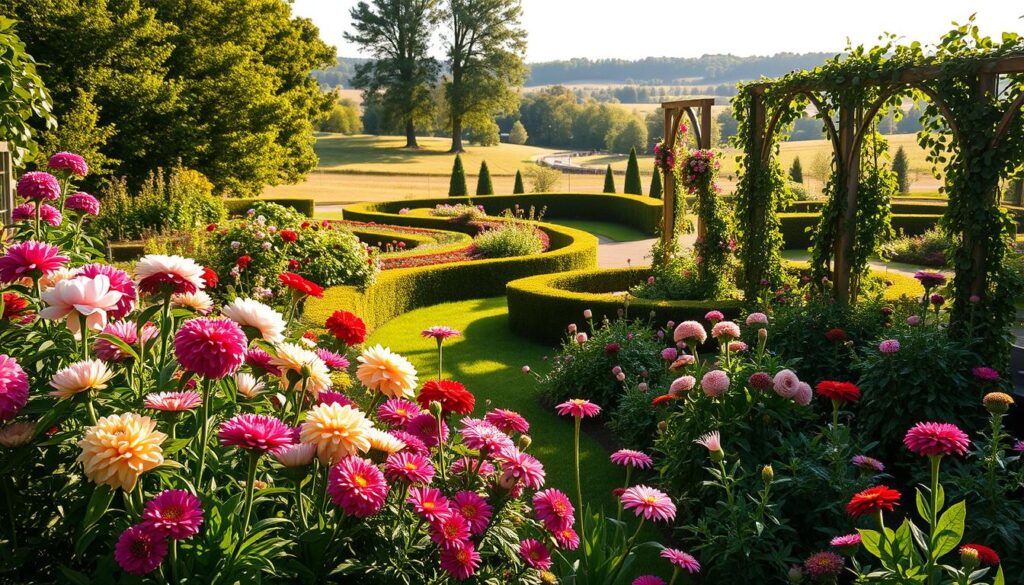
Choosing the Right Perennials
Selecting the best perennial plants ensures a steady supply of blooms. Start with peonies in spring, followed by lilies in summer, asters in fall, and sedum in late autumn. This staggered planting approach keeps your garden vibrant throughout the seasons.
Optimal stem production rates of 50 stems per square foot ensure you have plenty of flowers for arrangements. Focus on varieties that thrive in your climate and soil conditions to maximize growth and longevity.
Designing for Seasonal Blooms
Thoughtful design is key to a successful cutting garden. Group plants by bloom time and height to create a visually appealing layout. Incorporate post-harvest care techniques, such as flower food recipes, to extend the life of your arrangements.
Drying techniques for hydrangeas and statice allow you to preserve their beauty for months. If you’re considering a market garden, this setup offers profit potential while adding charm to your outdoor space.
“A cutting garden is more than just a source of blooms—it’s a way to bring nature’s beauty into your home.”
- Staggered planting: Peonies → lilies → asters → sedum
- Stem production rates: 50 stems/sq.ft optimal density
- Post-harvest care: Flower food recipes
- Drying techniques for hydrangeas and statice
- Market garden profit potential
Herb Garden Essentials
Growing your own herbs at home can be both rewarding and practical. Whether you’re a seasoned gardener or just starting, cultivating these versatile plants adds flavor to your meals and beauty to your space. From medicinal varieties to pest-repelling combinations, there’s an herb for every need.
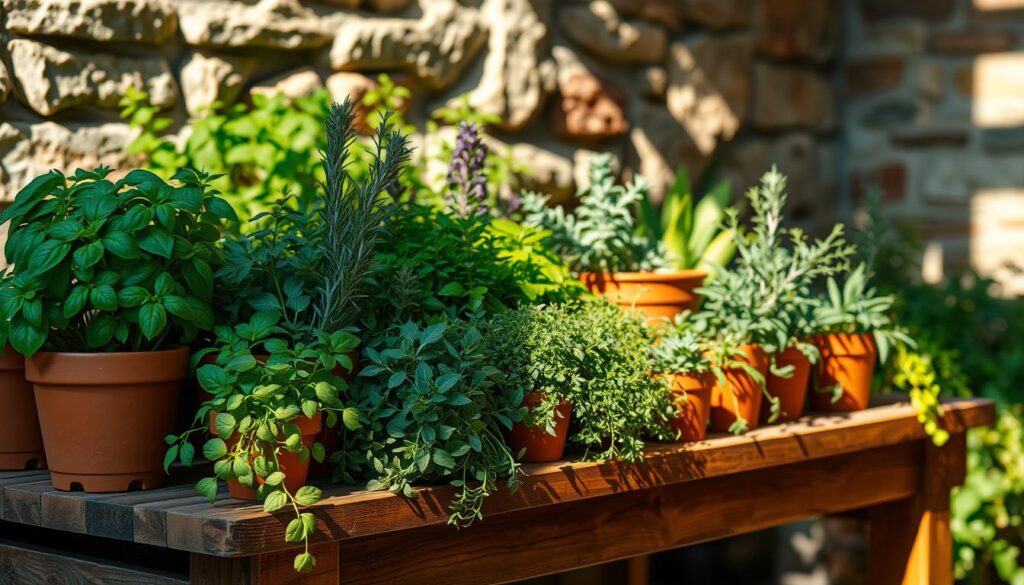
Best Herbs for Your Garden
Choosing the right herbs depends on your climate and preferences. Rosemary ‘Arp’ is a standout choice for northern areas, surviving temperatures as low as -10°F. Medicinal options like echinacea, lemon balm, and holy basil offer health benefits alongside their aromatic appeal.
For smaller spaces, consider window box-friendly varieties such as thyme, oregano, and chives. These compact plants thrive in limited areas and add fresh flavors to your cooking. Pairing mint with garlic borders can also naturally repel pests, keeping your garden healthy.
Container vs. In-Ground Herb Gardens
Deciding between containers and in-ground planting depends on your space and needs. Containers are ideal for urban settings or those with limited room. They allow for easy mobility and better control over soil conditions. A raised bed is another excellent option, offering improved drainage and easier access for maintenance.
In-ground gardens, on the other hand, provide more space for root growth and can support larger herb varieties. They’re perfect for those with ample yard space and a desire for a more natural look. Both methods have their advantages, so choose the one that best fits your lifestyle.
| Feature | Container Garden | In-Ground Garden |
|---|---|---|
| Space Requirements | Ideal for small spaces | Requires more room |
| Mobility | Easy to move | Fixed location |
| Soil Control | Customizable | Natural soil conditions |
| Maintenance | Easier access | More labor-intensive |
Preserving your harvest is just as important as growing it. Techniques like freeze-drying and oil infusion extend the shelf life of your herbs, ensuring you can enjoy them year-round. Overwintering methods, such as cloche protection or transitioning plants indoors, also help maintain your garden through colder months.
“Herbs are more than just plants—they’re a way to bring flavor, health, and beauty into your daily life.”
Cottage Garden Charm
Cottage gardens evoke a sense of timeless charm and natural elegance. These spaces blend structure and spontaneity, creating a relaxed and inviting atmosphere. With their mix of flowers, rustic elements, and wildlife-friendly features, they offer a unique way to enhance your outdoor area.
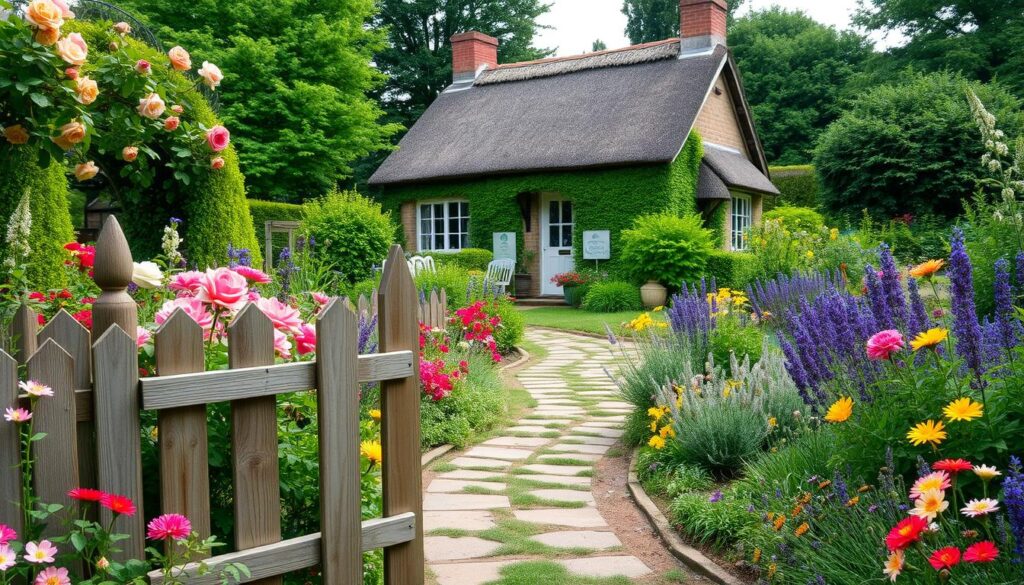
Key Elements of a Cottage Garden
To achieve the quintessential cottage look, focus on structural elements like rustic gates and stone pathways. These features add character and guide visitors through the space. Wildlife-friendly additions, such as hedgehog houses, also contribute to the garden’s charm and ecological value.
Monrovia’s plan suggests using 70% perennials and 30% self-seeding annuals. This combination ensures a balance of stability and natural growth. Naturalistic pruning techniques further enhance the garden’s relaxed, unmanicured appeal.
Plant Selection and Arrangement
Choosing the right plants is essential for a thriving cottage garden. Vintage rose varieties like ‘Zéphirine Drouhin’ and ‘Munstead Wood’ add a touch of romance and fragrance. Pair them with spring bulbs, summer roses, and autumn asters for a continuous bloom timeline.
Here’s a quick guide to arranging your flowers:
| Season | Key Plants | Features |
|---|---|---|
| Spring | Bulbs (tulips, daffodils) | Early color and freshness |
| Summer | Roses, lavender | Fragrance and vibrancy |
| Autumn | Asters, sedum | Late-season blooms |
By carefully selecting and arranging your plants, you can create a cottage garden that’s both beautiful and functional. Embrace the natural charm and let your outdoor space tell its own story.
Porch and Patio Garden Designs
Your porch or patio can become a lush retreat with the right approach. Even in compact spaces, you can create a vibrant outdoor area that feels both functional and inviting. Whether you’re working with a small balcony or a cozy corner, thoughtful design can make all the difference.

Maximizing Small Spaces
Small spaces require creative solutions. Monrovia’s 2024 guide suggests using dwarf citrus trees and columnar evergreens to add height without overwhelming the area. Vertical systems, like living walls with irrigation grids, are perfect for maximizing growing space.
Microclimate management is also key. Use windbreaks or shade sails to protect your plants from harsh weather. For containers, a soil mix of 50% potting soil, 30% compost, and 20% perlite ensures healthy root growth and drainage.
Choosing Plants for Patios
Selecting the right plants is essential for a thriving patio garden. Night-blooming varieties like moonflowers and night phlox add beauty and fragrance after sunset. ADA-compliant raised planters make gardening accessible for everyone.
Here’s a quick guide to creating a stunning patio space:
- Use vertical systems to save space.
- Choose plants suited to your microclimate.
- Incorporate night-blooming varieties for evening charm.
- Opt for ADA-compliant planters for accessibility.
“Even the smallest patio can become a green oasis with the right plants and design.”
Fragrant Garden Ideas
Imagine stepping into a yard filled with delightful scents that change throughout the day. A fragrant outdoor space not only enhances the beauty of your surroundings but also engages your sense of smell, creating a calming and immersive experience. By carefully selecting plants and thoughtfully arranging them, you can design a space that’s both visually stunning and aromatically pleasing.
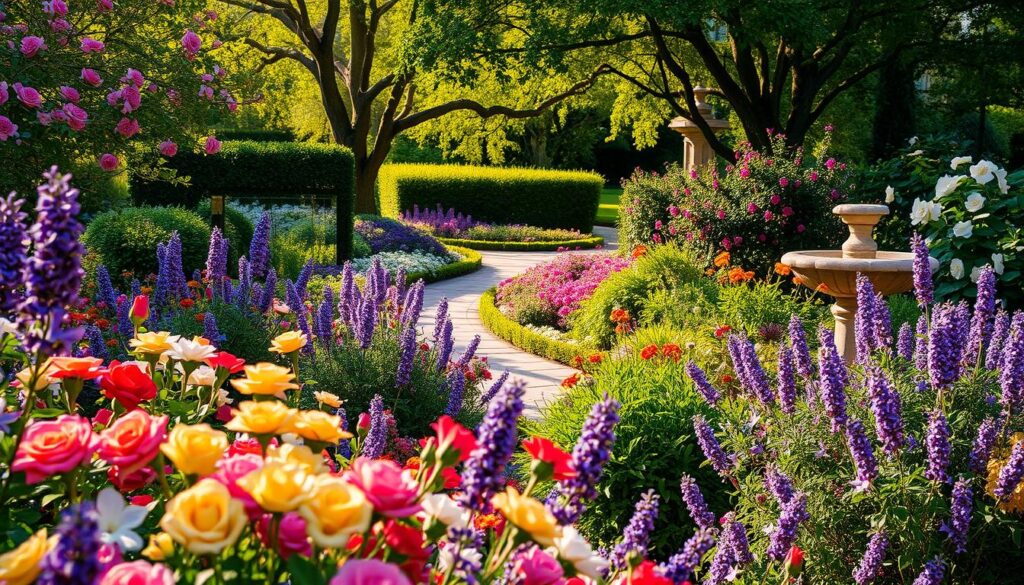
Plants with Pleasant Scents
Choosing the right plants is key to creating a fragrant garden. Monrovia’s 2023 Distinctive Selections highlights the ‘Sweet Tea’ gardenia, known for its intoxicating aroma. Other great options include heat-activated aromatics like pineapple sage and heliotrope, which release their scents in warmer weather. For allergy-friendly choices, consider freesia or pansies, which offer subtle fragrances without triggering sensitivities.
Designing for Aroma and Beauty
When designing your space, think about scent zoning. Place evening bloomers like moonflowers near seating areas for nighttime enjoyment, while daytime bloomers like lavender can be positioned along pathways. Materials like crushed herbs or scented mulch can release fragrance when stepped on, adding an extra layer of sensory delight. For a touch of whimsy, include flowers with scented foliage, such as chocolate cosmos or lemon verbena.
“A fragrant garden is more than just a visual treat—it’s a way to engage all your senses and create a truly immersive experience.”
Perennial Garden Plans
Perennial gardens offer lasting beauty and require less effort over time. Unlike annuals, these plants return year after year, making them a sustainable choice for your outdoor space. With proper care, they grow stronger and more vibrant, transforming your area into a low-maintenance haven.
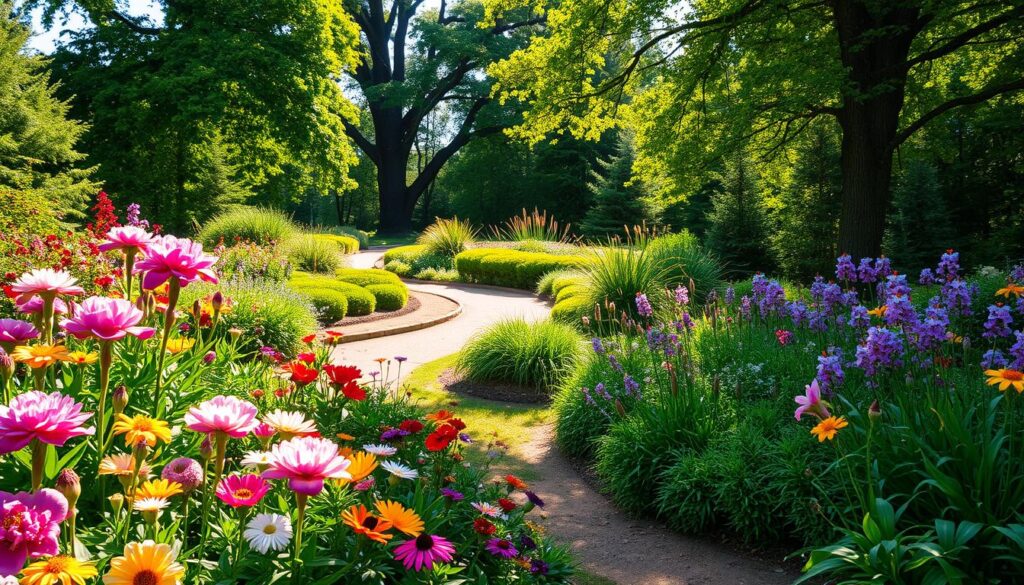
Long-Term Garden Benefits
Investing in perennials pays off in the long run. Monrovia’s 7-year study shows a 200% growth increase by year 3, highlighting their resilience and adaptability. These plants also reduce the need for replanting, saving time and money over the years.
Here’s why perennials are a smart choice:
- Cost-effective: Lower long-term expenses compared to annuals.
- Low maintenance: Once established, they require minimal care.
- Eco-friendly: Reduce waste by avoiding frequent replanting.
Selecting and Caring for Perennials
Choosing the right perennials ensures a thriving garden. Drought-tolerant stars like Russian sage and sedum are perfect for dry climates. For deer-resistant options, consider bleeding heart or foxglove. These plants not only survive but thrive with minimal intervention.
Here are some essential tips:
- Division schedules: Hostas every 5 years, daylilies every 3 years.
- Cutting back: Trim in late fall or early spring for healthier growth.
- Winter interest: Leave some plants untrimmed for seasonal appeal.
“Perennials are the backbone of a sustainable garden, offering beauty and resilience year after year.”
Water Garden Inspiration
Adding a water feature to your outdoor space can create a serene and inviting atmosphere. Whether it’s a small barrel pond or a flowing fountain, these elements bring a unique charm to your garden. They also support local ecosystems by attracting wildlife and promoting biodiversity.
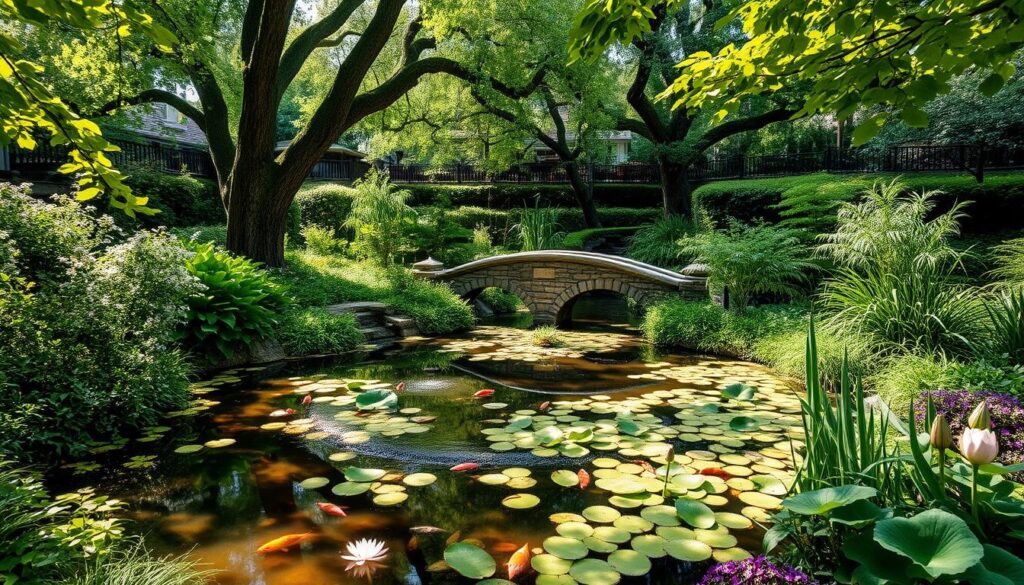
Designing a Water Feature
Start with a Whiskey Barrel Water Garden Plan for a compact yet impactful solution. This setup uses dwarf papyrus and water lettuce to create a balanced ecosystem. Aim for 60% plant coverage to maintain harmony and prevent algae overgrowth.
Solar pumps are an eco-friendly choice for circulating water. They’re easy to install and operate, making them ideal for beginners. For mosquito control, consider using Bacillus thuringiensis israelensis, a natural and effective solution.
Plants for Water Gardens
Choosing the right plants is crucial for a thriving water feature. Fish-safe options like water hawthorn and hornwort provide shelter and oxygen for aquatic life. These plants also enhance the visual appeal of your garden.
Winterizing your water feature ensures it survives colder months. Drain the system and store pumps indoors to prevent damage. Hardy plants can remain in place with proper protection.
“A well-designed water garden is more than just a feature—it’s a living, breathing ecosystem that enhances your outdoor space.”
| Element | Details |
|---|---|
| Plant Coverage | 60% ideal for ecosystem balance |
| Fish-Safe Plants | Water hawthorn, hornwort |
| Solar Pump | Eco-friendly and easy to install |
| Mosquito Control | Bacillus thuringiensis israelensis |
| Winterizing | Drain system, store pumps, protect plants |
Raised Bed Garden Plans
Elevate your outdoor space with the versatility of raised beds. These structures offer a practical way to grow healthier plants while improving soil conditions. Whether you’re a beginner or an experienced gardener, raised beds provide a structured and efficient solution for your growing needs.
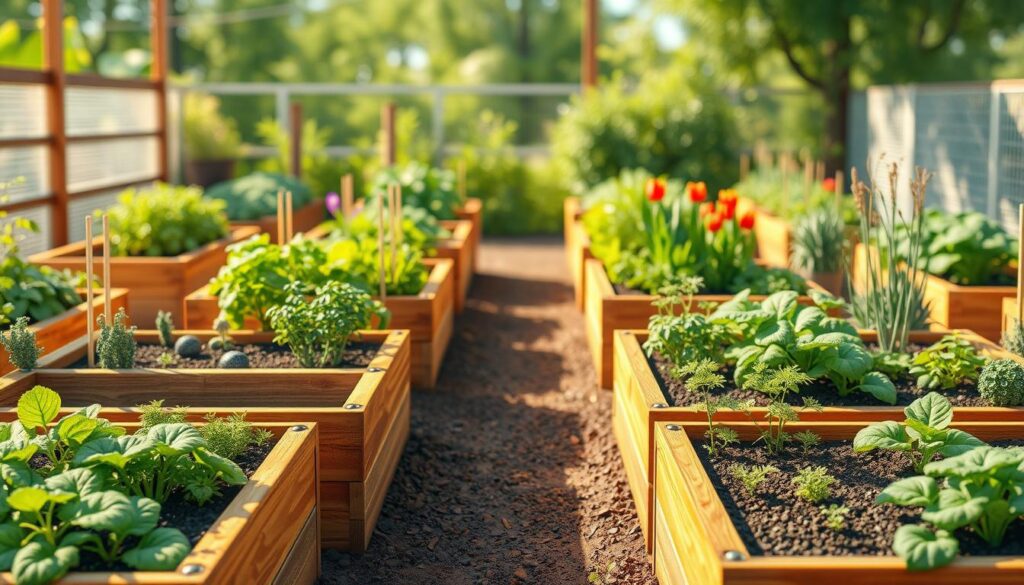
Benefits of Raised Beds
Raised beds come with numerous advantages. They improve soil drainage, reduce weed growth, and make gardening more accessible. According to Monrovia’s 2023 guide, a depth of 24″ is ideal for root vegetables, ensuring optimal growth. These beds also allow for better control over soil quality, making it easier to tailor conditions to your plants.
Accessibility is another key benefit. A height of 30″ makes these beds wheelchair-friendly, ensuring everyone can enjoy gardening. Plus, the structured design minimizes bending and kneeling, reducing strain on your back and knees.
Building and Planting Raised Beds
When constructing raised beds, material choice is crucial. Cedar is durable and naturally resistant to rot, while composite materials offer a longer lifespan but at a higher cost. Here’s a quick comparison:
- Cedar: Affordable, rot-resistant, and eco-friendly.
- Composite: Long-lasting but more expensive.
For a sustainable approach, consider the Hugelkultur layering technique. This method uses logs, branches, and organic matter to create a nutrient-rich base. It’s perfect for improving soil fertility over time.
Square foot planting charts can help maximize space. These guides ensure each plant has enough room to thrive. Additionally, an annual 25% compost top-up keeps the soil rich and productive.
“Raised beds are more than just a gardening trend—they’re a smart, efficient way to grow healthier plants and make gardening accessible for everyone.”
With the right setup, your raised beds can transform your outdoor area into a thriving, low-maintenance haven. Start planning today and enjoy the benefits of this versatile gardening solution.
Spring Bulb Garden Ideas
Brighten your outdoor space with vibrant spring blooms that bring life to every corner. These bulbs are an easy way to add color and charm, creating a seasonal wonderland that delights the senses. With the right selection and care, your area will burst with life as the weather warms.

Choosing the Right Bulbs
Selecting the best bulbs ensures a stunning display. Monrovia’s trial highlights the ‘Tête-à-Tête’ daffodil, which offers 92% squirrel resistance. For deer-proof options, consider alliums or fritillaria. These varieties not only add beauty but also protect your blooms from wildlife.
Layered planting is a great technique for continuous color. Start with tulips, followed by daffodils, and finish with crocus. This approach creates a dynamic, multi-layered effect that keeps your space vibrant throughout the season.
Planting and Care Tips
Proper planting is key to success. Use naturalizing techniques for meadows, allowing bulbs to spread and create a wild, natural look. For indoor blooms, follow a forcing schedule to enjoy flowers even before the season begins.
When storing bulbs, maintain the right temperature and humidity to ensure they remain healthy. A cool, dry place is ideal for preserving them until the next spring.
“Spring bulbs are more than just flowers—they’re a way to celebrate the season and bring joy to your outdoor space.”
- Layered planting: Tulips → daffodils → crocus
- Naturalizing techniques for meadows
- Forcing schedule for indoor blooms
- Bulb storage: Temperature/humidity guidelines
- Deer-proof varieties: Alliums, fritillaria
Winter Garden Beauty
Even in the coldest months, your outdoor area can radiate charm and vitality. A well-planned winter space brings warmth and life to the chilliest days. With the right plants and thoughtful design, you can create a serene retreat that celebrates the season’s unique beauty.
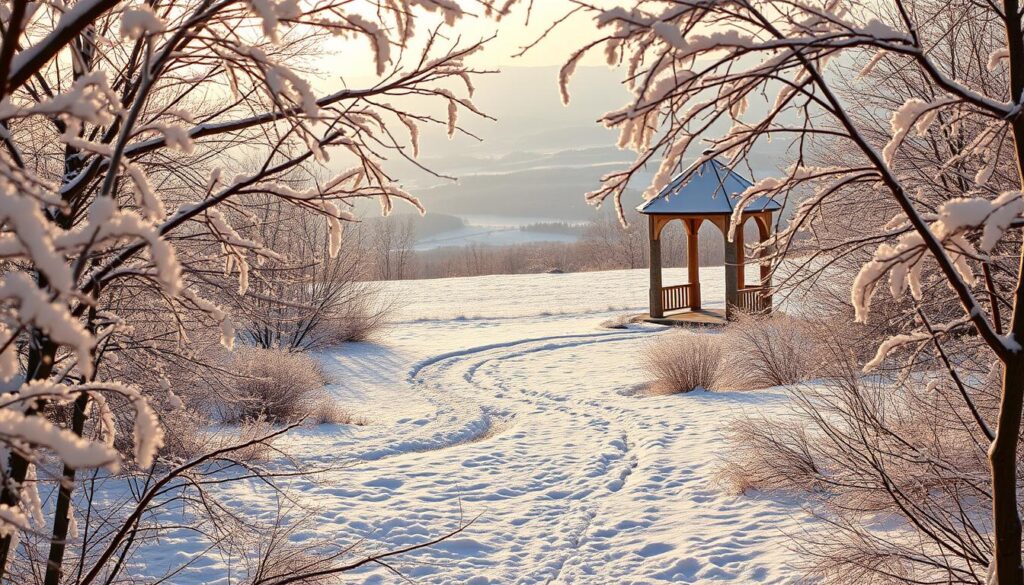
Plants That Bloom in Winter
Not all plants shy away from the cold. Hellebores ‘Winter Jewels’ series, for example, blooms even at 20°F, adding color to frosty landscapes. These hardy flowers are perfect for creating a vibrant winter scene.
Evergreen structures like boxwood pyramids and holly provide year-round appeal. Their lush greenery contrasts beautifully with snow, adding texture and depth to your space.
Designing for Year-Round Appeal
Bark interest is another way to enhance your winter design. Coral bark maple and red twig dogwood add striking pops of color, even in the darkest months. Their vibrant hues create a stunning visual impact.
Winter containers are a versatile option. Combine ornamental kale with birch branches for a festive, natural look. These arrangements are easy to maintain and add charm to patios or entryways.
Lighting strategies also play a key role. Uplighting specimen trees highlights their structure and creates a magical nighttime atmosphere. This simple technique transforms your space into a winter wonderland.
Don’t forget wildlife support. Winterberry provides food for birds, adding life and movement to your garden. These thoughtful touches ensure your space remains vibrant and welcoming all season long.
“A winter garden is more than just a space—it’s a celebration of the season’s quiet elegance and resilience.”
Conclusion
Transforming your outdoor area into a vibrant retreat starts with thoughtful planning. By focusing on key principles like space optimization and plants selection, you can create a beauty-filled sanctuary. Take it step by step—phased implementation ensures success without overwhelm.
Community garden projects offer added benefits, fostering connections and shared resources. Whether you’re a beginner or an expert, collaboration can elevate your design and inspire creativity. For more guidance, explore Monrovia’s downloadable resources to refine your vision.
Need inspiration? Check out our before-and-after gallery to see how small changes can make a big impact. Start your journey today and watch your outdoor space flourish. For beginners, this step-by-step guide is a great place to begin.

